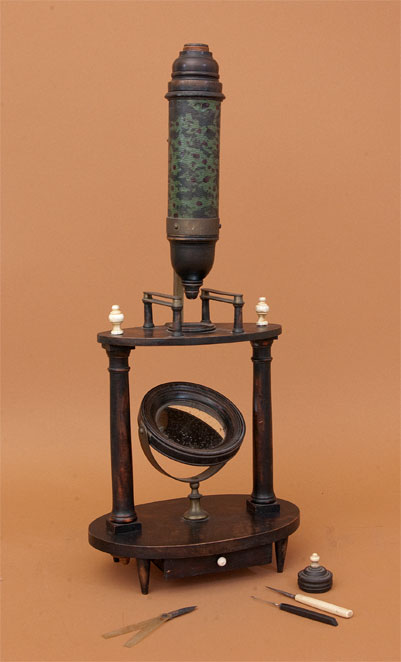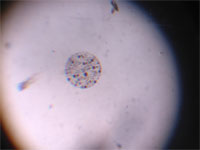One-of-a-kind Compound Microscope (No. 262)

Made by: unknown
Made in: possibly Italy


This instrument is a one-of-a-kind compound microscope made possibly in Italy in the early to mid 18th century. The microscope body has similarities to instruments from John Marshall (1663–1725), Mann, and others of the 1700s. [The Golub Collection has a Marshall microscope from 1710.] The maker of this instrument, however, modified the construction of the mechanical aspects of the instrument by adding a gimbaled mirror, elevated stage, single support pillar, and screw focus mechanism. These modifications suggest a manufacture date of between 1735 and 1750. The pearwood construction and mottled paper decoration of the cardboard body tube suggest Italian in origin. Clay and Court (1975, p106) describe an Italian microscope from c1750 that has a microscope body that is similar to this instrument in the Golub Collection.
This instrument has the single brass support pillar attached to the elevated sample stage, a screw focusing mechanism (Hevelius screw), and cardboard microscope body. The sample stage is supported by two wooden pillars attached to the base. This raises the sample holders to approximately 20cm above the desk. The microscope has a large illuminating mirror attached to a brass gimbal (introduced by Hertel, Marshall, and others c1716), which is mounted to the base. Focusing is accomplished by turning a brass screw behind the body, which moves the microscope up or down to focus on the sample. The microscope body consists of a barrel and draw-tube. These are made of cardboard, wood and decorated paper or velum. The body tube decoration is textured paper painted green with red and dark green splotches. The eyepiece is a drawtube made of vellum-covered cardboard and wood. The Huygenian eyepiece has a dust cap of wood topped with an ivory knob. Ivory knobs also secure the two wood pillars to the stage. The optics of this microscope consist of a three-lens system typical of this era. There is a two-lens eyepiece, the field lens, and a single lens objective. There is only one objective with this instrument. It is removable and consists of a single biconvex lens. The base plate supports an accessory drawer containing several tools for dissection.
Imaging using the only objective is poor, showing a resolution of approximately 0.1mm and magnification of about 10x. The total height of this microscope is 53cm.
Featured 07/2005, 07/2009